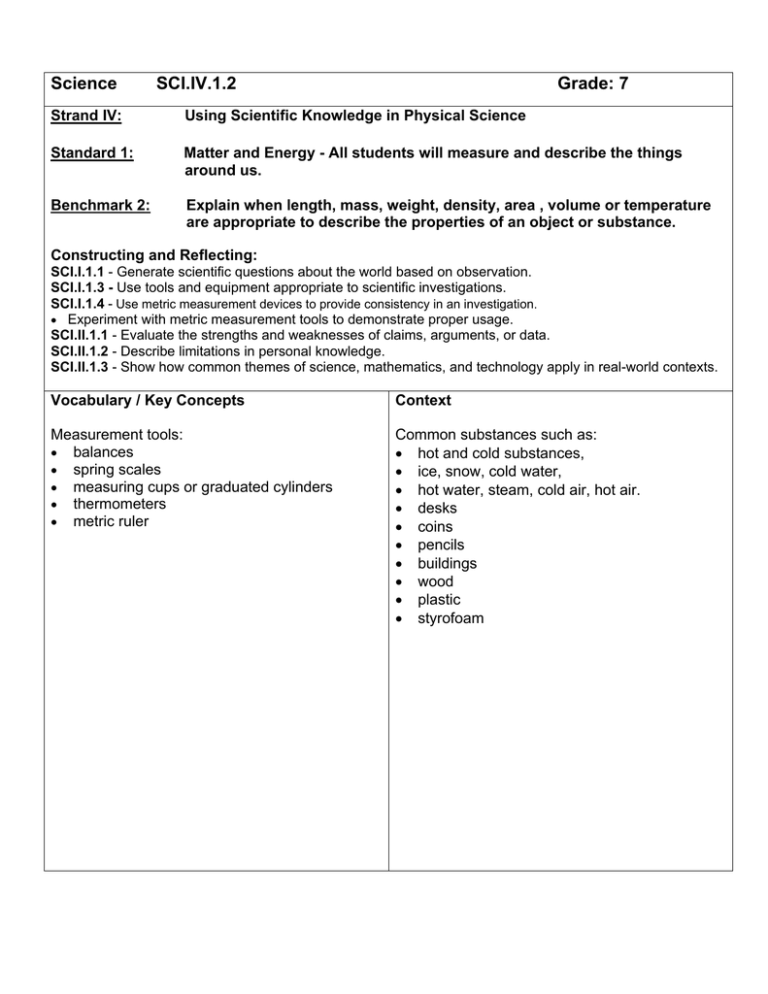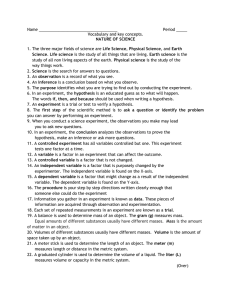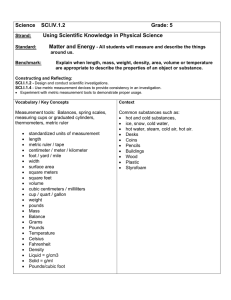Science SCI.IV.1.2 Grade: 7
advertisement

Science SCI.IV.1.2 Grade: 7 Strand IV: Using Scientific Knowledge in Physical Science Standard 1: Matter and Energy - All students will measure and describe the things around us. Benchmark 2: Explain when length, mass, weight, density, area , volume or temperature are appropriate to describe the properties of an object or substance. Constructing and Reflecting: SCI.I.1.1 - Generate scientific questions about the world based on observation. SCI.I.1.3 - Use tools and equipment appropriate to scientific investigations. SCI.I.1.4 - Use metric measurement devices to provide consistency in an investigation. • Experiment with metric measurement tools to demonstrate proper usage. SCI.II.1.1 - Evaluate the strengths and weaknesses of claims, arguments, or data. SCI.II.1.2 - Describe limitations in personal knowledge. SCI.II.1.3 - Show how common themes of science, mathematics, and technology apply in real-world contexts. Vocabulary / Key Concepts Context Measurement tools: • balances • spring scales • measuring cups or graduated cylinders • thermometers • metric ruler Common substances such as: • hot and cold substances, • ice, snow, cold water, • hot water, steam, cold air, hot air. • desks • coins • pencils • buildings • wood • plastic • styrofoam Knowledge and Skills Scientists use specific tools to measure specific properties of matter. They record these measurements in standardized units (metric units). It is important for students to become knowledgeable about the appropriate tools that are used to measure each property and the appropriate measurements that are used to describe the property. For instance, one wouldn’t measure a table with a balance and record the measurement in miles; the table would be measured with a metric tape and described in centimeters. Students will: • Construct a table of physical properties of matter, the units used to describe each property, and the tools used to measure each property • Use the appropriate tools to measure the size of an object and the amount of a substance in the object • Students will use and explain the appropriate measurements for describing the size of an object and amount of a substance. For instance, one wouldn’t measure a table in miles. • Measuring Property • Tool (Units) length, width, height area metric ruler (meters) volume weight graduated cylinder, ruler, measuring cup (cubic centimeters, milliliter) spring scale (Newtons, pounds) mass balance (grams) temperature thermometer (Celsius, Kelvin, Fahrenheit) density those used for mass and volume (g/ml - liquid) (g/cm3 –solid) Density = Mass/Volume Resources Coloma Resources: “Density Dunk Activity” – students get into a tank to find their densities. Wat-ar Densities (lab) – Aims Activity p.s. Floaters & Sinkers Lava Lamps & Density lab Activity How many properties do you need? describe different objects according to their properties and then classify them according to their similarities. (Objects can include small classroom items.) Other Resources: • SMILE Program Physics- Mechanics – 95+ lessons, labs and activities to make sense of measurements – IL Institute of Technology • Physical Science Activity Manual –book written by a group of teachers using the learning cycle and 34 activities to teach physical science. Excellent resource! • Michigan Teachers Network Resources • SCoPE Unit – Measuring Up • ExploreLearning – Fundamentals and Measurements – excellent site – free preview, but requires subscription. • MSU unit Matter and Molecules • Density of Student • AIMS – Balloons • Science Explosion: “Measurement oh Measurement”, “Words & Tools of Measurement” 7th Grade Science Curriculum Technology Resources IV.1.MS.2 Vernier probes available: Temperature Probe, Force Sensor Instruction Benchmark Question: How do we measure matter? Focus Question: What is the appropriate equipment and metric units used to describe the size and amount of a substance? Set up workstations with the following instruments: metric ruler, metric stick, graduated cylinder, measuring cup (with printed measures on the side), spring scale, balance, and thermometer. Have students measure a variety of commonly found solids, and liquids (water, wood block, box, vegetable oil, rubbing alcohol, etc.). Have students in groups discuss their results and possible reasons for error. Going Beyond: Challenge the students to find the volume, mass and density of carbon dioxide that is formed when mixing vinegar and baking soda using a balloon. Coloma Science Project: (Required Assessment) Students will construct a formal science project including questions, hypothesis, information, data, procedure, conclusion and an abstract. Projects will be presented to judges and will be displayed in Media Center for one week. After completing the project, students will have used measuring skills, graph making skills, and will have acquired a knowledge of the scientific method. A rubric for scoring is used. Assessment Students will be given a variety of objects in which they choose 6 objects to create a chart which include estimate and actual measure of length, volume, mass, area, density and temperature. In the room, various measuring devices will be available for them to use. Before each measurement is made, students should estimate the measurement and include the unit of measure. Objects could include: different types of breakfast cereal of different shapes, dry and “wet”: breakfast cereal, water and different types of soda in varying quantities, different kinds of candy, powdered and liquid laundry detergent, classroom materials, and containers of different sorts. (Give students rubric before activity.) Scoring Rubric Criteria: Correctness of units – Apprentice - Contains two or fewer correct units. Basic - Contains three to four correct units. Meets - Contains five or six correct units. Exceeds - Contains all correct units with additional objects measured. Criteria: Appropriateness of tool Apprentice - Contains two or fewer correct choices of tools. Basic - Contains three to four correct measurements (+/- 2 units). Meets - Contains five or six correct choices of tools. Exceeds - Contains all correct choices of tools with additional objects measured. Criteria: Correctness of measurement Apprentice - Contains two or fewer correct measurements. Basic - Contains three to four correct choices of tools. Meets - Contains five to six correct measurements (+/- 2 units). Exceeds - All objects are measured correctly within +/- 2 units. Temperature would end up the same as air for all objects. (liquids could be varied) Density would have to be a relative ranking for estimated part. Teacher Notes: Scientists describe and compare objects and substances by measuring them using standardized equipment. Objects have size (length, area, volume), mass, weight and temperature. Substances have density (a property that is independent of the amount of the substance). (JCISD) Focus Question • • • How can objects be described in terms of mass, volume and temperature? How is the density of an object different from its mass or volume? When is it appropriate to measure the weight of an object rather than its mass, or density rather than volume? 1. Choose a problem to solve. 2. State your problem as a specific question. 3. Research your problem. 4. Form a hypothesis. 5. Plan your project. 6. Set up a time schedule. 7. Make a list of all the materials you will need. 8. Collect all your materials. 9. Conduct your experiments, several times. 10. Record the data 11. Organize the data in a more orderly form. 12. Draw conclusions from the data. 13. Prepare your report, graphs, drawings, and diagrams. 14. Construct your science fair display. 1. a collection of related or unrelated objects 2. a list of things 3. a report not supported by data or an experiment 4. a model, illustration, or piece of equipment unrelated to an experiment Once you have chosen your science problem, it is important to research the written materials available on your subject. By finding out as much background information as you can about the subject, you will gain a better understanding of your problem. This will be valuable to you as you plan your project. Following are guidelines for conducting this research. 1. Read books and articles on your subject, Make sure this information is up-to-date (usually not older than five to ten years, depending on the subject). . 2. Interview and talk with people who are knowledgeable about your subject. 3. Keep a record of your information in a notebook or on index cards. 4. List all of the references you use. These will be included in your final report. Examples of references follow. Books: Author's last name, Author's first name, Title Of Book, Publisher, Publication date. Example: Starr, Ringo, Beetles in the Woods, Bantam Books, 1988. Articles: Author's last name, Author's first name, "Title of Article," Name of Periodical, Publication date, pages used. Example: Watson, Peter, "Making Ugly Dolls," Mad Magazine, August 1988, pp. 136-145. 5. It is also a good idea to list those people who helped you in any way. For example: "I was helped in my research by Joe Montana, Craig Luckenbach, Albert Einstein, and by Pat Lewis who helped me build my display." 6. When you have completed your research, form a hypothesis. A hypothesis is an educated guess in which you propose a possible solution to your problem based on your research. Having a hypothesis helps you to focus your project. Your experiments will either prove your hypothesis to be correct, or they will disprove it. When you have completed your research, you will need to create a work schedule for the project itself. Your work schedule will include gathering the materials and equipment you'll need to conduct your experiments, doing the experiments and recording the data, writing your report, and designing and building your science fair display. Always give yourself more time than you think you will need for each step, so unexpected problems don't cause you to become anxious or to rush through the steps. When working out your schedule, think about the following: 1. How will I go about solving my problem? What is my goal? What do I want to show, prove, or disprove? 2. What materials and equipment will I need? Make a detailed list of everything you will need for the project, including the experiments and the science fair display. 3. What experiments will I need to conduct? Remember that you will need to run your experiments several times to get truly accurate and valid data. 4. How will I go about collecting and recording my observations, data, and conclusions? 5. How much information will I want to include in my final report? 6. How do I want my science fair display to look? What kind of background would look best? How will it be built? 7. What should I include in my display? Consider including samples, models, illustrations, graphs, charts, tables, photographs, diagrams, written reports, and equipment from your experiments. IT IS IMPORTANT that you do not become discouraged if your experiments or projects do not work out exactly as planned. Scientists learn as much from their many “failed" experiments as from the few which prove successful. Often, with a little thought, you can develop a new way to state your conclusions that will be more satisfying than reporting a negative result. Remember: no project is a failure; you learn from it, no matter what its results are. Don't give up too soon! JUDGING CRITERIA FOR SCIENCE FAIR – COLOMA MIDDLE SCHOOL (PLEASE CIRCLE THE NUMBER YOU JUDGE TO BE MOST APPLICABLE FOREACH CATEGORY. USE 5 AS THE BEST AND 0 MEANING THAT NONE OFTHE CRITERIA HAS BEEN MET FOR THE CATEGORY. STUDENT NAME CATEGORY PROJECT NUMBER COMMENTS I. PROBLEM TO BE INVESTIGATED The problem is clearly stated. 0 1 2 3 4 5 11. HYPOTHESIS The hypothesis is clearly described and is experimentally testable. The hypothesis is a reasonable guess for a solution. 0 1 2 3 4 5 III. TEST PROCEDURE The testing method is clearly described and is logical and appropriate to the problem/solution. The testing includes enough trials to be accurate and includes a control where appropriate. 0 1 2 3 4 5 IV. DATA The data are complete and consistent with the testing method used. The data uses appropriate labels and units of measurement. 0 1 2 3 4 5 V. RESULTS AND CONCLUSION The results are clearly stated and the conclusions are consistent with the hypothesis. The results are easy to understand and are shown in graphs, charts, or tables. 0 1 2 3 4 5 VI. NEATNESS/APPEARANCE 0 The overall display and presentation of the project is neat, orderly uses correct spelling and gives the impression of careful work. Materials labels, lettering, and Descriptions are neatly and clearly presented. 1 2 3 4 5





